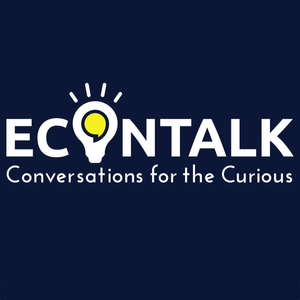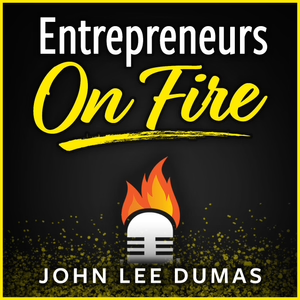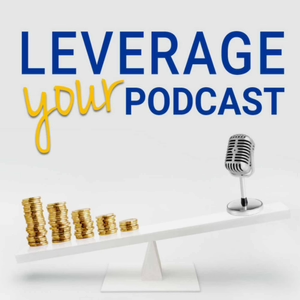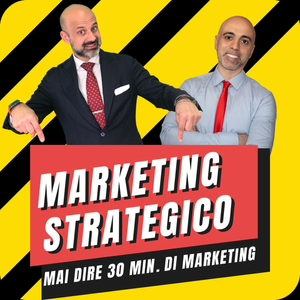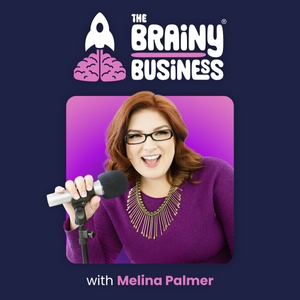
88. Marketing to Mindstates: A Discussion With Author, Will Leach
02/21/20 • 38 min
1 Listener
Companies are getting more savvy about using behavioral economics not only to sell products, but to help consumers make better choices. Will Leach has taken the concepts of behavioral economics and social sciences to the next level with his book Marketing to Mindstates: The Practical Guide to Applying Behavior Design to Research and Marketing. I am very excited to talk with him today. He is the founder of the behavioral consultancy TriggerPoint. Previous to starting his business, Will led behavioral science methods at PepsiCo, and he has won numerous awards for his innovative work in behavioral economics.
When reading Will’s book, I knew within the first few pages that he needed to come on the podcast. This is even before I realized that he got his master’s from Texas A&M University (I talked about the Texas A&M Human Behavior Lab in episode 33 where I interviewed Dr. Marco Palma.) Will and I had a lot of fun talking about the lab and team down there before we jumped into the interview. Will was at A&M before the lab was built, but we have both seen it in person thanks to Dr. Palma.
Will does such a great job of breaking down a really complex area of marketing into a formula that any business can follow – from global corporations like PepsiCo to small businesses. One area I know non-marketers (and even many marketing teams to be honest) struggle with is determining their target market and really narrowing it down and then knowing how to properly communicate with them. Will and I talk about his and the concept of the 18 different mindstates and nine motivations. He also shares his step by step process to help you determine which is the best for your company. This is an innovative and mind opening interview.
Show Notes:
- [03:46] For Will, behavioral economics was the classic “I didn't know it existed until I stumbled upon it.”
- [03:56] Will joined the military right out of high school. He then studied classical economics.
- [04:16] He discovered marketing research through a graduate program and fell in love with it. It wasn't just looking at economics, it was looking at why people do what they do.
- [04:39] While working at PepsiCo, he discovered behavioral economics and behavioral science. In 2009, PepsiCo invested $20 million in a laboratory to study the neurological impacts of messaging.
- [05:08] Will was lucky enough to get to run behavioral science experiments, and he loved it so much he started his own business and wrote a book about it.
- [05:55] His favorite project was working on a brand new snack. It was a healthy baked hummus chip. The brand called Wicked Crisps was designed using purely behavioral sciences. The target market was the owner's daughter (or millennial moms). Will helped design the name, logo, tagline, bag, and website. Behavioral science was behind everything that they designed from fonts to benefits.
- [11:58] Will studied economics. He didn't want to just talk about theory. He wanted a practical book.
- [13:02] He conveys specific models through story.
- [14:01] He also dug into motivational psychology and goal theory. He looked at all six social sciences and found patterns.
- [16:25] Will thinks of mindstates as moments in time when we are being influenced. We aren't always consistent with our beliefs and attitudes. Our environment changes us.
- [18:20] His book is about moments in time and why a certain archetype may behave outside of the norm for them. Applying mindstates can help understand beliefs and values and impacts of the environment on these moments.
- [20:57] Companies now look at how to help customers make better choices. Making their whole life better gives the company permission to sell them more. Brands are getting smarting and taking a holistic approach.
- [24:46] Will is the most excited about the idea of getting the mindstates out for everyone to use. They want to get more and more people to understand that there is science behind our decisions. There are also emotions around our decisions and just understanding a few small rules is a huge benefit.
- [25:57] We can sell more with behavioral economics. We can also reduce anxiety levels and create a better society.
- [26:30] Will is getting more excited about the education side and using these concepts to help understand and overcome biases.
- [27:02] He uses goal theory to help understand what people are trying to accomplish. Helping people reach their goals can create a better society.
- [29:39] The nine motivations are achievement, autonomy, b...
Companies are getting more savvy about using behavioral economics not only to sell products, but to help consumers make better choices. Will Leach has taken the concepts of behavioral economics and social sciences to the next level with his book Marketing to Mindstates: The Practical Guide to Applying Behavior Design to Research and Marketing. I am very excited to talk with him today. He is the founder of the behavioral consultancy TriggerPoint. Previous to starting his business, Will led behavioral science methods at PepsiCo, and he has won numerous awards for his innovative work in behavioral economics.
When reading Will’s book, I knew within the first few pages that he needed to come on the podcast. This is even before I realized that he got his master’s from Texas A&M University (I talked about the Texas A&M Human Behavior Lab in episode 33 where I interviewed Dr. Marco Palma.) Will and I had a lot of fun talking about the lab and team down there before we jumped into the interview. Will was at A&M before the lab was built, but we have both seen it in person thanks to Dr. Palma.
Will does such a great job of breaking down a really complex area of marketing into a formula that any business can follow – from global corporations like PepsiCo to small businesses. One area I know non-marketers (and even many marketing teams to be honest) struggle with is determining their target market and really narrowing it down and then knowing how to properly communicate with them. Will and I talk about his and the concept of the 18 different mindstates and nine motivations. He also shares his step by step process to help you determine which is the best for your company. This is an innovative and mind opening interview.
Show Notes:
- [03:46] For Will, behavioral economics was the classic “I didn't know it existed until I stumbled upon it.”
- [03:56] Will joined the military right out of high school. He then studied classical economics.
- [04:16] He discovered marketing research through a graduate program and fell in love with it. It wasn't just looking at economics, it was looking at why people do what they do.
- [04:39] While working at PepsiCo, he discovered behavioral economics and behavioral science. In 2009, PepsiCo invested $20 million in a laboratory to study the neurological impacts of messaging.
- [05:08] Will was lucky enough to get to run behavioral science experiments, and he loved it so much he started his own business and wrote a book about it.
- [05:55] His favorite project was working on a brand new snack. It was a healthy baked hummus chip. The brand called Wicked Crisps was designed using purely behavioral sciences. The target market was the owner's daughter (or millennial moms). Will helped design the name, logo, tagline, bag, and website. Behavioral science was behind everything that they designed from fonts to benefits.
- [11:58] Will studied economics. He didn't want to just talk about theory. He wanted a practical book.
- [13:02] He conveys specific models through story.
- [14:01] He also dug into motivational psychology and goal theory. He looked at all six social sciences and found patterns.
- [16:25] Will thinks of mindstates as moments in time when we are being influenced. We aren't always consistent with our beliefs and attitudes. Our environment changes us.
- [18:20] His book is about moments in time and why a certain archetype may behave outside of the norm for them. Applying mindstates can help understand beliefs and values and impacts of the environment on these moments.
- [20:57] Companies now look at how to help customers make better choices. Making their whole life better gives the company permission to sell them more. Brands are getting smarting and taking a holistic approach.
- [24:46] Will is the most excited about the idea of getting the mindstates out for everyone to use. They want to get more and more people to understand that there is science behind our decisions. There are also emotions around our decisions and just understanding a few small rules is a huge benefit.
- [25:57] We can sell more with behavioral economics. We can also reduce anxiety levels and create a better society.
- [26:30] Will is getting more excited about the education side and using these concepts to help understand and overcome biases.
- [27:02] He uses goal theory to help understand what people are trying to accomplish. Helping people reach their goals can create a better society.
- [29:39] The nine motivations are achievement, autonomy, b...
Previous Episode

87. Social Proof: How to Use Herding to Boost Engagement and Sales
Social proof was introduced by Robert Cialdini in his book Influence. It’s one of the six principles of persuasion (accompanied by reciprocity, scarcity, authority, consistency, and liking). I talked about social proof in last week's episode on Peloton. I talked about the infamous ad that made Peloton have a dramatic drop in market value, but I also talked about all of the things they were doing right and how they were using availability, priming, stacking and bundling offers, money back guarantees, reciprocity, choice architecture, herding and...of course...social proof.
I’ve heard from many of you who are actually considering getting a Peloton after that episode. That wasn’t my intention, but something I love to hear because we have been so happy with ours (and it is an example of the third type of social proof - users). Herding and social proof are closely related. When social proof is present, we are more likely to herd. We also look for social proof because it helps us validate our decisions. I’ll talk about the six types of social proof which are expert, celebrity, user, wisdom of the crowd, wisdom of friends, and certification. I’ll show how our biased brains are susceptible to social proof, ways it shows up, and how easily it can be implemented in any business – and why it is important to incorporate it.
Show Notes:
- [02:28] Social proof is closely related to herding.
- [02:39] The concept of social proof was first introduced by Robert Cialdini. Cialdini’s 1984 book Influence: The Psychology of Persuasion introduced the concept of social proof as one of the six principles of persuasion (the others are reciprocity, scarcity, authority, consistency and liking).
- [03:34] Social proof and herding feels a bit like a chicken and the egg situation. We are a herding species, we look for social proof to validate our decisions and be accepted by the group, but when social proof is present...we are more likely to herd. Which came first?
- [04:31] Having a lot of other people (or the right people) who have made the same choice in the past (regardless of whether or not it is a good one) is the social proof we need to nudge us into making the same choice.
- [05:01] You may be using social proof in your business or have seen it used in other businesses. Now you have scientific proof that these methods work.
- [05:19] The six types of social proof are: expert, celebrity, user, wisdom of the crowd, wisdom of friends, and certification.
- [05:52] Expert social proof would be when someone who is an expert in the industry recommends or speaks on behalf of a product or service. An expert extends a halo effect to the organization who brought them there.
- [06:37] Be aware of authority bias. People are conditioned to believe those who are in authority.
- [07:55] In your business, consider who an expert is on a topic, and how you might be able to bring them in to interact with your audience.
- [08:35] Experts lend credibility and the value of social proof to a brand – they make people feel comfortable about working with you.
- [08:59] Celebrity: There is a clear value in having a celebrity talk about your product.
- [10:01] You need to reach the right people in a way that will encourage them to take action.
- [11:12] Microinfluencers can impact your business by reaching the people who are likely to buy.
- [11:50] Just because a celebrity is easy to get, doesn’t’ mean they are a good fit for you or your brand. It is important to be discerning and make sure there is alignment.
- [12:08] The perceived personality of the celebrity carries over onto the perceived personality of the brand.
- [12:45] Have a user talk about your product. You could also stack this with a celebrity who used your product.
- [13:16] Incorporating users includes reviews and testimonials.
- [13:30] People are more likely to be influenced by those who they consider to be like themselves. This is the herding piece in action, along with our personal biases toward our own in-group.
- [15:25] Cialdini's towel example shows how incredibly powerful social proof can be.
- [15:46] A genuine user talking about the product is influential. When you can help people to see that others like them have found value from your business, it is a win.
- [16:42] I find key moments to mention that I have clients and people do work with me. It helps people to see that others like them work with me.
- [18:26] For testimonials: you do not need to write out the complete testimonial OR put the name of the person who provided it.
- [21:51] Understand why you are using the testimonial and why it matters to the person making the decision, and only use the important pieces.
- [24:16] Wisdom of the crowd is when someone follows you on Twitter and you look at their pr...
Next Episode

89. Focusing Illusion: Why Thinking About Something Makes It Seem More Important Than It Is (A Behavioral Economics Foundations Episode)
In a previous episode, I talked about a study on happiness which found that when asked if people thought they would be happier if they were to suddenly be a paraplegic or suddenly win the lottery, most everyone believes they would be happier winning the lottery and significantly less so to lose the use of their limbs.
In actuality, these two groups of people – paraplegics and lottery winners, are essentially just as happy as anyone else.
Why would this be and why would people predict it incorrectly? It has everything to do with the focusing illusion. When people only focus on one piece of a giant puzzle that piece ends up with far too much weight. Losing the use of your legs or winning the lottery is just one small piece of an entire life. There are so many factors that play into happiness, and while these pieces are significant and impactful in many ways, they don’t tend to have an impact on overall happiness like we think they would.
This episode is all about the focusing effect and how these principles can be used in your business and your life. I talk about focusing on that one thing and making it incredibly clear to your target market. I also talk about asking yourself what people should focus on when thinking about your brand and what would motivate your ideal customer to take action.
Show Notes:
- [04:44] A study about happiness that illustrates the focusing illusion.
- [05:47] Kahneman did a test back in 1998 to find out if Californians or Midwesterners were happier with their lives.
- [06:24] If you said Californians, you would be wrong. A focusing illusion bias puts more weight on things like sunshine and a seemingly laid back lifestyle. People adapt to their surroundings.
- [07:06] “Nothing in life is quite as important as you think it is while you are thinking about it.” - Daniel Kahneman
- [07:53] Focusing on something, not surprisingly, puts a whole bunch of attention on it.
- [08:59] Think about decluttering and how you would feel getting rid of something you might need. The focusing illusion is combining with counterfactual and prefactual thinking to maintain your status quo bias and keep you stuck.
- [09:54] When you are asked to think about how happy someone would be or how angry something would make you or how satisfied you are or would be...your brain will focus WAY too much on a few key aspects and answer in a way that is just not in alignment with reality.
- [10:47] Social proof. People are more likely to take action based on the thoughts and actions of others. They are also likely to weigh a few key items as the most important indicators of their happiness.
- [12:32] Our brains are split up into two processing systems: the subconscious is super busy filtering through 11 million bits of data per second, while the conscious can only handle 40 bits per second. Your brain will sort through all of the data to validate what you're focused on.
- [13:20] Anything you want to believe (or that all important first impression) will be supported by the focusing illusion.
- [13:36] Another example by Kahneman from Thinking, Fast and Slow using the halo effect.
- [15:25] Initial traits in a list changed the very meaning of the traits that appear later. The sequence in which we observe characteristics of a person is often determined by chance. Sequence matters, however, because the Halo effect increases the weight of 1st impressions.
- [16:40] When you are focusing on something, a particular aspect, you build it up in your mind and it changes your perception, expectation, experience, and memory of an experience.
- [17:20] There's a high likelihood that you will create bias in questions asked on surveys - hire an expert.
- [18:08] Focusing on finding examples to back up your brain’s earlier perceptions is confirmation bias.
- [19:17] It's good to take a step back and ask yourself if your bias may be guiding your interactions.
- [19:48] I share the story that was inspiration for this episode.
- [22:02] Live that truth and focus on that now. Your brain will focus on what you want it to.
- [23:34] Think about your approach to a project – what you focus on, the way you do things (or the way the company does things).
- [24:31] The problem that is facing you may not be as big of a deal as it seems – and something you aren’t even aware of could create a much bigger impact if you took the time to look for it.
- [25:36] A story about a detergent company fixing an obvious pain point and communicating it in their advertising.
- [26:32] Find the one or two points of value and talk about those...all the other features and benefits are extra.
- [27:12] Focus on that one thing and make it incredibly clear to your target market.
- [28:12] The mindstate guides the focusing effect and what the subconscious...
If you like this episode you’ll love
Episode Comments
Generate a badge
Get a badge for your website that links back to this episode
<a href="https://goodpods.com/podcasts/the-brainy-business-understanding-the-psychology-of-why-people-buy-beh-136281/88-marketing-to-mindstates-a-discussion-with-author-will-leach-6676958"> <img src="https://storage.googleapis.com/goodpods-images-bucket/badges/generic-badge-1.svg" alt="listen to 88. marketing to mindstates: a discussion with author, will leach on goodpods" style="width: 225px" /> </a>
Copy
